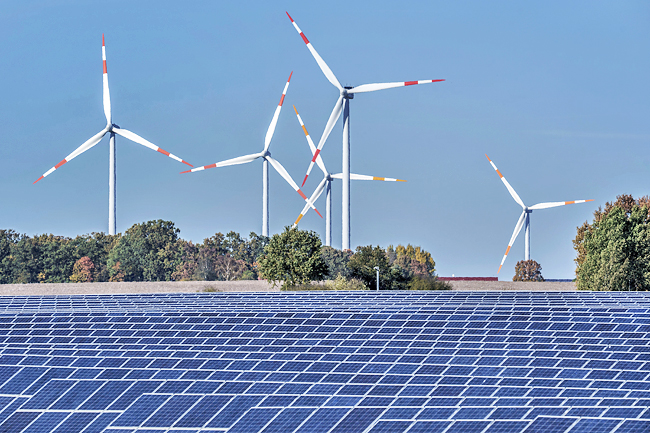Last month, the Summit for a New Global Financial Pact in Paris underlined the need to close the gap on climate finance by driving investment in the clean energy transition in emerging and developing economies. This is a pivotal year, in which the international community must back words with action–and COP28 is a vital moment for countries around the world to agree on concrete steps to stop the 1.5 °C goal from slipping out of reach and avoid the worst impacts of climate change.
The International Energy Agency’s (IEA) Roadmap to Net Zero Emissions by 2050 shows that we need to scale up viable clean energy technologies massively in the interim to achieve a major reduction in global emissions by 2030. This is a fundamental step on the road to net zero. Achieving this goal will require a wide range of clean energy technologies–but two areas are especially important: energy efficiency and renewable power. To put it simply, the world needs to double the current rate of global energy efficiency progress and triple its total renewable power capacity. A major scaling up of clean energy globally is critical to bring down demand for all fossil fuels.
The urgency of the situation was reflected in the COP28 Presidency’s recent call to action alongside the European Commission–and highlighted when Kenya joined with COP28 to champion the drive to triple renewables in Africa by 2030.
With the global energy crisis highlighting the energy security and affordability benefits of clean energy, promising political signals are being matched by concrete action. In the past two years, the growth in the deployment of solar panels has been fast enough to align with the rate envisaged in the IEA’s pathway to net zero emissions by 2050. Meanwhile, EV sales are soaring in major markets, heat pumps are challenging gas boilers in many countries, and more and more governments are rallying behind energy efficiency. These trends are supported by a strong policy push in multiple markets.
But let’s be clear: These positive trends on their own are still nowhere near enough. A high cost of capital weighs heavily on many potential new clean energy projects. Despite solar’s surge, the progress of wind, hydropower, and biofuels is lagging. Electricity grids aren’t expanding fast enough to accommodate increases in supply from renewables. And growth in energy efficiency investment is expected to slow this year.
Even more worryingly, there is a major global divide in the funding needed for the clean energy transition. Emerging and developing economies account for four-fifths of the world’s population, including all 775 million people who lack access to electricity, as well as the 2.4 billion people who lack access to clean cooking fuels. These are also the economies where future emissions will mostly come from–and where the cost of reducing emissions is cheapest. Yet currently, they represent less than half of global investments in clean energy.
To shift the world onto a path towards the 1.5 °C goal, a new report just published by the IEA and IFC shows that annual investment in clean energy in emerging and developing economies will need to more than triple from $770 billion today to as much as $2.8 trillion a year by the early 2030s.
The investment also needs to be spread far more widely across the emerging and developing world. Today, it is concentrated in a handful of large economies. China, India, and Brazil account for more than three-quarters of the total. China alone deployed 100 gigawatts of solar in 2022, almost 10 times the 11 gigawatts of solar that have been installed across the entire African continent in the past several decades.
All sources of finance–public and private, concessional and non-concessional, domestic and international–will need to rise significantly to deliver a clean energy future and advance sustainable development goals in emerging and developing economies. Investment in grid infrastructure and distribution networks is critical to deliver energy to the end user.
A suite of measures that improve the functioning of financial markets and boost the amount of finance flowing to emerging and developing economies is needed: from increasing the size and better leveraging the use of risk mitigation tools from the international community and development finance institutions, to making expected project returns more attractive to institutional investors.
Today, energy investments in emerging and developing economies rely heavily on public sources of finance. However, in a pathway towards the 1.5 °C goal, around 60% of the finance for clean energy investment in these economies (not including China) will need to come from the private sector.
Strong regulatory and policy measures, including power sector reforms and pricing signals, are needed to allow for private investment and steer financing decisions toward cleaner and more efficient solutions to reduce emissions. Efficient and competitive power markets create the foundations allowing for private investment. Many other barriers that hinder investors will also need to be addressed, including inefficient subsidies that tilt the playing field against clean energy investments, lengthy permitting procedures, unpredictable procurement practices, lengthy procedures for licensing, arbitrary or weak contract enforcement, restrictions on private or foreign ownership, and poor creditworthiness of counterparties.
Every stakeholder must play their part–including oil and gas companies, which need to set out and deliver on aggressive targets to cut their greenhouse gas emissions by 2030 and significantly increase their investments in clean energy.
We call on all countries, companies, and other actors to come together at COP28 to deliver an ambitious outcome that drives real action to fund a just transition for all emerging and developing economies.
Sultan Al Jaber, Ph.D., is the president-designate of COP28, the UAE’s minister for industry and advanced technology, special envoy for climate, chairman of Masdar, and group CEO of the Abu Dhabi National Oil Company (ADNOC).

